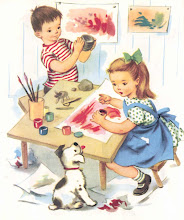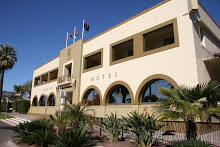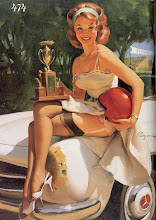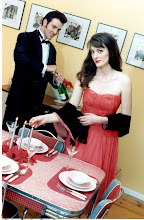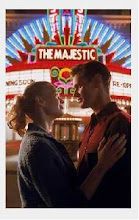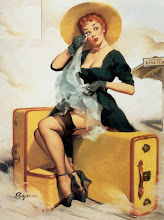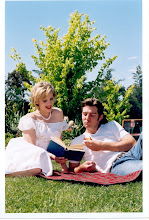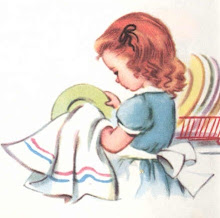.jpg)
My lovely readers, as you enjoy this story, please keep in mind that this book was written over 10 years ago by a very neive, romantic and history loving 20ish year old, intent upon capturing and preserving the legends, as well as the architectural heritage, of the homeland area she loved. As such, much of the present day facts have altered - for example, Cobram Estate Olive Oil is now very sucessful and widely recognised, but at the time this was written, was only just getting its start - and the language and writing style used are the simple, uneducated musings of myself, aged 20ish. Hoping you enjoy just the same - and again, biggest thanks to the lovely Brooke Orchard for the photographs from so long ago !
Cobram Homestead
In 1854, the banks of the river Murray were still and
quite with the occasional tribe of natives the only human inhabitants. Wrens
and Kingfishers flourished in the riverlands, inquisitive grey kangaroos and
wide-eyed possums enjoyed the plentiful food amidst tall trees and grasses.
Little wonder that the sight of a
paddlesteamer – the “Lady Augusta” – held small cause for concern and much
cause for intrigue when it chuffed it’s way through the region. How could anyone
living on the river banks then have known that the coming of white man would
bring so many changes?
The “Lady Augusta”, with her load
of passengers, was the first of the riverboats to pass through the
Cobram-Barooga Forests, steaming it’s way upstream from Echuca. Yet there was
one person who had beaten them to this area of natural abundance. Octavious
Phillpotts, son of the Bishop of Exeter, owned the vast cattle station of
Cobram.
Stretching along the Victorian side of
the muddy waters, Octavious had been overseeing the 128,640 acres of Cobram
Station since 1845. He had drawn the name Cobram from his Koori friends along
the riverside, a friendly tribe whom he had come to know well during his 19
years of occupancy. However, by 1864, for reasons undocumented, Phillpotts
decided to draw a close to his involvement in early Australian “squatacracy” at
Cobram. Selling his station, complete with coach house, stables and quaint
colonial timber homestead, he left the breathtaking river views and moved on.
It wasn’t until 1880, 16 years later,
that Cobram was purchased by a family who would begin to turn the station and
it’s homestead into a magnificent property of local repute. For 26 years, Hugh
Dick battled the floods and droughts and economic crashes that coloured
Australia’s agricultural industry in the late 1800’s, as he built up Cobram
Station.
Following the economic strains brought
on by drought and depression in the 1890’s, life took a prosperous turn for the
Dick family on Cobram Station. The Dick family had held onto their property
when many around them were going bust, and as such, it was now time to build
for the future.
In 1906
Hugh began work on his fine station homestead. High on a sandhill, the
homestead was to overlook the river in three directions, and stretching away to
the West, the expanse of his cattle station. With verandahs spanning the house
on every side, glorious views of the river, fattened cattle, rivergums and
orange orchard were available to every beholder.
Hugh Dick quite obviously desired a home
that would suit his family, and a garden that would honour his wife whom he
loved deeply. Set out in the driveway is a heart shaped carriageway. Brimming
with roses and set off with healthy date palms, the inner lawn of Hugh’s love
heart garden is a sweet momento of his devotion. Elsewhere, the grounds were
filled with stately trees – magnolias, figs, locust, palms and peppercorns. A
gardener was employed to tend the flower beds and roses, while Hugh Dick
implemented the watering of his grounds from the river through irrigation.
For 110 years the Dick family held
Cobram Station, 84 years of which was lived out in the elegant homestead.
However, with the passing of time, so to goes the passing on of land.
In 1990 Cobram change hands, and was run
as a bed and breakfast hosting such notables as Julie Anthony, a former
Governor, and the band Midnight Oil. However, 6 years later, wanting a change
in life direction, the host and hostess had Cobram again up for sale.
A wise stock and station agent sent
Melbourne engineer, Ken Dugan, a brochure for the sale of Cobram in 1996. At
first Ken wondered what he could possibly do with a river property, but decided
to drive up from Melbourne and have a look none the less. At the sight of the
peppercorns at the front gate, Ken was hooked, their weeping branches reminding
him of childhood farm visits. The river view and date palm trees totally won
him over – there was no tuning back, Cobram was sold.
The Dugans have been hard at work
in their new home as well as on the land. The old scullery, laundry and kitchen
have been transformed into one spacious, sunny kitchen with superb views of
deck, garden and river beyond. Out on the deck, which is constructed on the
foundations of an old water tank, one can look out to an island in the river
which makes up part of the station land. A large forested area, accessible by
bridge or even by dry crossing in times of drought, it was used for cattle
grazing in days of yore, but nowadays it hosts campers and fishermen keen for
relaxation on the river.
Surrounding the homestead stand some
remnant out buildings, reminders of an
almost closed portion of history. The Cobram carriage house stands as solid as
the day it was built in the early 1850’s. It’s shingle roof has been covered
with corrugated iron, but the shingles can still be seen from inside the musty
building. With a reputation for housing black snakes, which Ken assures
visitors usually “nick off” when people arrive, the carriage house still
shelters a hay wagon. A fairly modern looking item, it is occasionally
harnessed to George, a mighty 16 year old Sulfolk Punch
When the Dugans arrived at Cobram, they
discovered a rickety old hut, which, unlike the carriage house, fell over with
one little push. Long before the federation homestead was built, the Dick
family employed a man for the simple task of hunting rabbits on Cobram. He
lived by the rolling river in an old tent. Kind heartedly, Hugh Dick had a hut
built for him, in which to rest his weary bones. The rabbit mans shack, like
the necessity for the rabbit man himself, did not see out the ticking over of a
new millenium.
Deep in a shadowy corner of the Cobram
garden is what the Dugan grandchildren affectionately call the “fairy garden”.
Happy hours are spent in the fairy garden, where the children play under the
all seeing eye of a chirpy looking gnome. The magic of a fairy spell is almost
woven by the well known verse he watches over on a stone tablet…
“The kiss of
the sun for pardon,
The song of the birds for mirth
One is nearer
God’s heart in a garden
Than anywhere
else on earth”
The simple little verse aptly sums up
the feel of Cobram Homestead with it’s mirthful birds and sunny corners.
Essentially it has changed little, despite the planting of olive groves and New
Zealand willows flickering in the breezes either side of the sandy drive. It
remains harmonious and graceful, still pulsating with the wildlife that first
watched the Lady Augusta paddlesteamer sail past all those years ago. Then, the
picture of Cobram was serenely peaceful in its simple bushland. Today, when the
orange grove comes alive on a dusky summer’s eve, with sprinklers bursting,
blowing prisms of water everywhere through mellow sunlight, Cobram is still the
embodiment of the serene peace of an Australian country homestead.
.jpg)
.jpg)
.jpg)
.jpg)
.jpg)
.jpg)
.jpg)
.jpg)
.jpg)
.jpg)
.jpg)
.jpg)
.jpg)

.jpg)
.jpg)



















.jpg)




.jpg)




.jpg)









